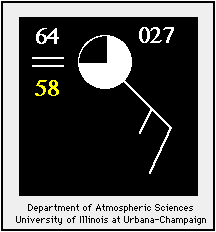|
Observed Dew Point Temperature
indicates the amount of moisture in the air
The value highlighted in yellow located
in the lower left corner (in the diagram above) is the
dew point temperature in degrees
Fahrenheit.
In this example, the reported dew point temperature is 58 degrees.

Dew points indicate the amount moisture in the air.
The higher the dew points, the higher the moisture content of the
air at a given temperature.
Dew point temperature
is defined as the temperature to which the air
would have to cool (at constant pressure and constant water vapor content)
in order to
reach saturation. A state of saturation exists when the air is holding the
maximum amount of water vapor possible at the existing temperature and
pressure.
When the dew point temperature and air temperature are equal, the air
is said to be saturated.
Dew point temperature is NEVER GREATER than the air temperature.
Therefore, if the air
cools, moisture must be removed from the air
and this is accomplished through condensation. This
process results in the formation of tiny water droplets that can lead
to the development of fog, frost, clouds, or even precipitation.
Relative Humidity
can be inferred from dew point values.
When
air temperature and dew point temperatures are very close,
the air has a high relative humidity. The opposite is true when
there is a large difference between air and dew point temperatures, which
indicates air with lower relaitve humidity.
Locations with high relative humidities
indicate that the air is nearly saturated with moisture; clouds
and precipitation are therefore quite possible.
Weather conditions at locations with high dew point temperatures
(65 or greater)
are likely to be uncomfortably humid.

weather
|
|

cloud cover
|
|


